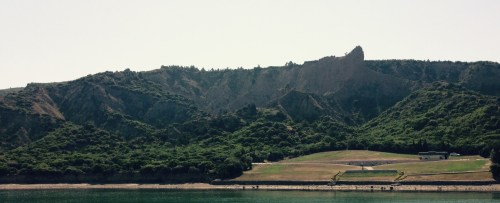The Big Island
I’m not on it (the Big Island) any more, and I’m pretty glad about that. Apparently last night there was another 5.5 earthquake right under the village I was staying in, and I didn’t enjoy the one I had in the daytime, night time would have been worse.
But I feel as though I’d left out some details in my haste to get into area where nothing could fall on me. My main impression of the Big Island, apart from the Goddess Pele having a moment, is that it doesn’t really seem to be set up for tourists.
Now this is curious, the native villagers of Volcano, the closest village to the National Park, were bemoaning the lack of tourists in the area. Like they would normally have a lot. And yet, even with the tiny handful that they had, they weren’t sure what to do with them. The village is in a rainforest, and yet not only did my accommodation have no umbrellas to lend the passing guest, the local shop didn’t sell them either. I know this because when I finally located my accommodation, I couldn’t face getting back in the car again and driving on the right even more, so I decided to walk the kilometre or so to the local shops. Shortly after I started walking I noticed two things. One, it had started to rain. Two, there were no footpaths. Three, actually, the grass at the side of the road was very swampy and one could sink up to one’s ankles in it if one stepped off the road to let a truck go past.
Nor did the local shop, when I finally sloshed in, have umbrellas, rain ponchos, any rain attire at all, anything that resembled food, a working ATM, or any suggestions for something for visitors to do (the visitors centre was open, but unoccupied but for a note suggesting that the local shop might have some suggestions). It wasn’t for lack of will either. The tiny woman at the counter with giant eyes was very keen to suggest something, she was sure that some part of the park was open, she had heard it on the news, her husband knew what it was called and where it was, it had some hiking, there were park rangers, what could it be called? I was in sympathy with her, I’ve had a lot of trouble remembering Hawaiian names. It’s as if they’d been given a Scrabble rack of consonants and told they were the only ones they could use, but go nuts with the vowels. It turned out to be Kahuku, an hour down the road, and it did have some lovely walks, but nothing specifically volcanic.
That’s another thing, you have to have a car. There are no shuttles, buses, or any public transport to speak of, though I did see an entirely inexplicable train carriage in someone’s front yard on one of my many drives. There seems to be a lot of poverty on the island, most houses looked like something you’d see built by someone’s grandpa in far west NSW, and occasionally you’d see a plot of land with just a couple of tents and a caravan on it. I did go to Pahoa, where the roadblocks preventing stickybeakers getting drowned in the lava are, but I didn’t stay long because it was full of dirty hippies.
There were quite a lot of groups of them, and they were clearly local, as evidenced by the vegan icecream shop, the crystal shop, and the massive natural foods shop, where I bought some locally produced lip balm with bee venom in it. It works really well, giving ones lips an alarming tingling sensation, but I do wonder how you’d react if you were allergic. The Guide to Hawaii describes the town as “historic”, with quaint wooden shops, but to me it looked like a dump. I’d show you photos if I had better wifi. There was a wheelchair outside one shop with a case of bananas in it. Some of the hippies were sitting in the gutter smoking ganja. Then one of them got out a ukulele and started playing Star Man. David Bowie on the ukulele. One cannot put up with that kind of thing, so I didn’t stick around for the night time glow in the sky, but hightailed it out of there.
None of the tourist guides mentioned the Keck Observatory, which I drove past on my way to the airport. On my way, haha. There really is only one way, Highway 11 that goes around the island. I’d come in via the southern half, I left via the northern half for completeness. And there, in Waimea, right next to McDonalds was the visitors centre for one of the largest optical telescopes in the world. Naturally I spent a lovely half hour in there learning all about all of the engineering behind it, which countries used it on what kinds of projects, but I won’t bore you with it, pop in if you have a chance, it’s fascinating.
Having circumnavigated the island now, I can kind of understand why it is so underdeveloped. The entire island has lava scars over it. You really wouldn’t want to invest a whole lot of money in something that could be buried by molten rock in a couple of decades. I just made myself research the Keck Observatory, because that is obviously a massive investment, but the huge peak that is on is dormant, and lava from the active bit can’t flow uphill.
All I have left to say about the Big Island of Hawai’i is that I’ll have to go there again when Pele is feeling better. And that it is infested with mongooses.


































